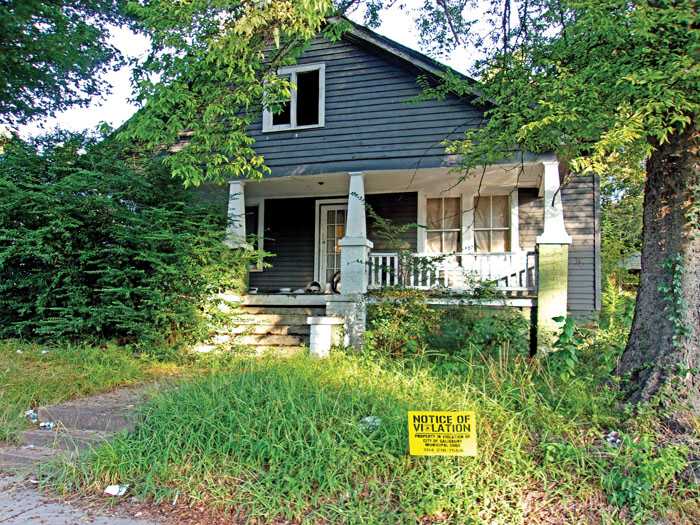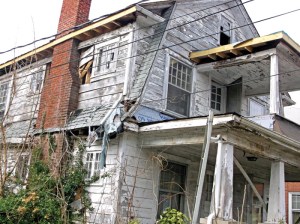In Salisbury, housing demolitions come with months of work from three local officers
Published 12:10 am Sunday, March 14, 2021

- Submitted photo — A house located at 728 South Jackson St. is currently among the dozen properties that qualify for demolition in the 2020-21 fiscal year. It has a compliance date of April 27, in which demolition will occur following approval from city council if the structure isn't brought up to code.
By Natalie Anderson
natalie.anderson@salisburypost.com
SALISBURY — The decision to demolish a house or structure deemed past the point of no return can be beneficial for public safety, overall beautification and a subsequent increase in property tax values.
Though it’s still the city’s last option, it’s preceded by months of work handled by three local officers who spend their days ensuring all of Salisbury’s housing stock is up to code.
Code Services Manager Michael Cotilla along with code enforcement officers Michael Buchanan and Kenneth Graham, enforce nuisance ordinances, minimum housing standards and zoning ordinances within the city limits. Examples of nuisance issues include overgrown grass, trash and debris and furniture on porches. Zoning ordinance violations can be the result of illegal signage or businesses operating without proper registration. Issues related to minimum housing standards involve the enforcement of living conditions in rental properties.
Each officer monitors one of the city’s three designated jurisdictions, and officers are equipped to stay on the road all day. Following the arrival of the pandemic, trucks were equipped with laptops and printers to issue citations. Complaints can be filed at salisburync.gov/311, where they’re assigned to officers within minutes.
The process leading to demolition is a long one. A structure must first be deemed “dilapidated,” or “beyond the scope of repair.” Dilapidated also means more than 50% of the property’s tax value is needed to bring the structure up to code.
By contrast, deteriorated properties can usually be resolved with general appearance repairs to avoid fees and fines.

Submitted photo — A house located at 209 West Marsh St. is currently among the dozen properties that qualify for demolition in the 2020-21 fiscal year. It has a compliance date of April 13, in which demolition will occur following approval from city council if the structure isn’t brought up to code.
Officers use county records and an extensive title search to issue orders of compliance to not only the owner, but also all heirs. The owner is then required to attend a hearing to discuss plans for the structure moving forward.
Owners have a period of 90 days to either bring the structure up to code or it will be demolished, though extensions are offered if significant progress is being made to the property. Owners will sometimes opt to demolish the structures themselves, but if they have no intent to do so, code enforcement officers will try and obtain permission to move forward with the demolition.
All demolitions the department handles must first be approved by city council members. Following the demolition, owners are invoiced and have 10 days to resolve the cost of the demolition or a lien is placed on the property, which prevents the owner from selling or transferring a title until the demolition fee is paid.
In cases where the owner or heirs cannot be notified, an ad is published in the Post.
The decision to demolish a house or structure is the city’s “last resort” option as it’s more beneficial to see homes be restored and put into active use, especially in the historic district.
“It’s one of the tools in our toolbox when we’ve run out of other options,” said Hannah Jacobson, the city’s planning director.
Demolitions can also help remove “eyesores” in the community, which leads to increased property tax values and an improved morale among the neighborhood.
Other times, demolitions make room for future developments. Such is the case at 504 East Liberty Street, where a burned house was demolished in the 2019-20 fiscal year.
“And as we speak, there’s three houses being built,” Cotilla said. “Three structures that are potentially going to be rental properties or affordable (housing).”
Most importantly, however, is overall public safety. Dilapidated structures can often harbor criminal activity and pose fire hazards, city officials say.
Code enforcement officers often help alleviate the burden on the Salisbury Police Department, particularly with disputes between neighbors due to nuisances. Capt. Melonie Thompson said complaints are often relayed to code enforcement officers, but the nature of the activity can result in a charge of trespassing, drug use and breaking and entering vacant homes. Other times, especially in the winter, homeless locals will use a vacant home for shelter. In those cases, code enforcement officers and the police are able to work with Rowan Helping Ministries to provide resources.
Thompson said Salisbury Police officers also work with code enforcement to mitigate illegal dumping.
“We rely a lot on the community to let us know when they see things,” Thompson said. “People can get hurt in these abandoned properties.”
In 2018-19, a total of 12 properties were deemed chronic condition, Cotilla said. Only five of those structures were demolished, while the remaining properties were either sold and purchased or the owners chose to demolish the structure themselves.
In the following fiscal year, 12 properties were deemed chronic, with nine of those eventually demolished. For the 2020-21 fiscal year, Cotilla has identified 21 properties but plans to focus on 13 of them. Of those 13 properties, four are undergoing restorations and repairs by the owners, while three were privately demolished and another three remain under a year-long Historic Preservation Commission delay. He anticipates about three or four properties soon going to city council for approval to move forward with demolition.
Each demolition can range from $3,000 for smaller structures to as much as $10,000 for larger ones.
Some houses currently deemed dilapidated include 209 West Marsh St. and 728 S. Jackson St., which have compliance dates of April 13 and April 27, respectively.
The pandemic resulted in a reduction in the number of citations issued overall. Though Cotilla notes it’s hard to judge the quality of work by the number of citations issued, he reports a total of 2,631 cases were cited in the 2017-18 fiscal year, 3,102 cases in 2018-19 and 1,902 cases in 2019-2020. By June 30, the end of the current fiscal year, he expects around 1,650 cases to be cited.
Cotilla also attributes the decline to the awareness that he and his team are patrolling neighborhoods for any potential violations.
“I see that decline in numbers as a good thing,” he said.
Additionally, the number of regular minimum housing inspections, which was once 2-3 per day, have dwindled down to only a couple each week. Cotilla said 95% of those issues are resolved with a phone call to local landlords or property managers.
Currently, the average rate of compliance from citations issued is between 81-83%. It’s always more beneficial for issues to be “self-abated” by the property owners, Cotilla said.
Cotilla said in 2019 officers became more proactive by knocking on property owners’ doors. For that reason, “people either love us or hate us,” he added.
“They don’t want us knocking on your door and telling you, ‘You have to cut your grass,’ or telling you, ‘You need to move your vehicle’ because it’s defined as a junk vehicle for our ordinance,” Cotilla said. “A lot of folks nowadays still have that mentality that, ‘It’s my property and I can do whatever I want on it.’ But simply and unfortunately when you live in the corporate limits, that’s not the way it is.”
Jacobson said she hopes to continue seeing a decline in the number of citations issued, and attributes the decline to the quality of services delivered by all three code enforcement officers. She likened them to being “unsung heroes.”



